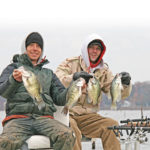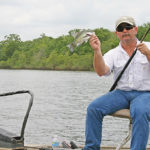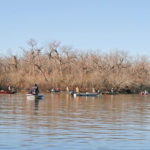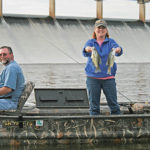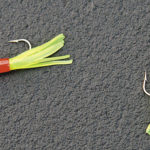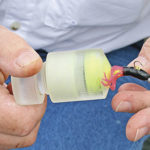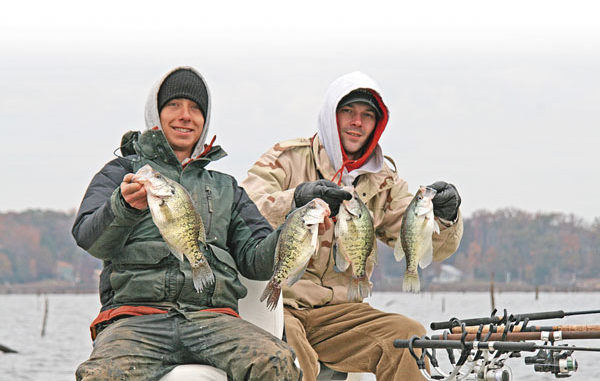
March is Louisiana’s best crappie month, but the notoriously finicky fish like things their way.
Sometimes when you’re crappie fishing, it seems you can’t go wrong. When the white perch are biting, they gulp down just about anything you offer in any manner you choose.
But more often than not, crappie are just downright finicky. Your trusty Humminbird unit may clearly show concentrations of baitfish and crappie right below the boat, but nothing you do can entice them to bite. What’s even more frustrating is to be among a bunch of boats and watching one person haul in slab after slab when no one else is catching a thing.
In those cases, that one lucky fisherman is probably doing something just slightly different that the others have overlooked. The old saying “the devil is in the details” truly applies to crappie fishing.
Size matters
As in other areas of life, size really does matter when it comes to catching white perch. Take jigs, for example. A well-stocked tacklebox should have jigs and jig heads in a variety of sizes because all jigs are not equal in certain situations.
For decades, I used only a 1/32-ounce jig head simply because that was the size I first learned to fish. It didn’t matter the time of year or how deep the fish were. I stayed with what I was comfortable using.
But, over time, I came to realize something. During the winter when crappie bunch up in deep water, a jig might need to get down 20 feet or more. I discovered through trial and error that my lightweight jig often was not reaching the desired depth even though the line looked like it was hanging straight down.
A lightweight jig simply cannot overcome line drag, current and boat movement to get down real deep. And the bad thing was I often didn’t even know it.
Instead of having my jig dangling in front of hungry crappie 20 feet down, it was holding out of sight several feet above them.
Now I’ve learned to adjust my jig to the depth I’m fishing, and use a 1/8-ounce jig when I want to get down really deep.
On the other hand, there are times when the small 1/32-ounce jig is the one to use. It is particularly effective when you’re not sure at what depth the fish are holding or they are scattered through the water column.
If you examine a crappie carefully, you’ll notice the eyes are positioned to look up for prey. Crappie will come up for a bait, but they rarely will go down.
So if you don’t know how deep the fish are, use a light jig so it drifts down slowly and gives the crappie a longer opportunity to spot it. If you use a heavy 1/8-ounce jig head in those situations, it will zip right past them before they can attack.
I remember one particular trip to Saline Larto when the small jig made my day. It was May, and the spawn was over. The crappie had moved back into open water, and boat loads of fishermen were probing the deeper bayou channels.
I had fished those same spots without success. Finally, about noon, I decided to try an inlet off the main channel.
When I flipped my jig out, I noticed the line did not sink. Thinking it had landed on a submerged stump, I picked it up and found I had a nice crappie.
Several more followed, none being more than 18 inches deep. I wound up with 40 in a couple of hours.
If I had been using a heavier jig, it would have passed through the shallow strike zone too quickly, and I would have never known the fish were holding just under the water’s surface.
Size also matters in the line you use. Another mistake I made for years was keeping my jigging pole spooled with 14-pound line. I target crappie everywhere — deep water and shallow, and in open water and tree tops.
Hang-ups are common, and the heavier line allowed me to retrieve most of my jigs when I got stuck. On the other hand, that size line also produces an incredible amount of drag and makes it almost impossible to get a jig down deep.
Now, I tailor the line to the situation. A medium to heavy line is fine when fishing shallow flats, stump fields or tree tops, but when going deep, I change over to 6-pound line. The increased number of fish I catch makes up for the jigs lost to hang-ups.
Veteran crappie fisherman Randy Hulin also believes fish can see the heavier line.
“When you’re fishing relatively clear water, the heavier line sometimes will spook the fish,” he said. “Using a light line for your jigs can make a big difference in getting them to bite.”
Rather than changing out his entire spool when the situation calls for lighter line, Hulin simply attaches a light leader to his 10-pound line, and ties the jigs to it.
Line size is particularly critical when fishing gin-clear lakes like Caney and Claiborne. A friend of mine learned this while fishing the latter lake many years ago.
Near him was an elderly man who was steadily dragging in slabs, but my friend couldn’t get a bite. After trying everything in his tackle box, he finally got up the nerve to ask the old fellow for advice.
“What size line are you using?” the man asked.
When my friend replied 10-pound-test, the fisherman let him in on his secret.
“You’ve got to go smaller so you don’t spook the fish,” he said. “I’m using 4-pound line. This water is so clear, it makes a big difference. Just take your time and don’t try to horse them in.”
My buddy cranked up and ran back to the landing, bought some 4-pound line, came back, and wore them out on the very same baits he couldn’t get a bite on earlier.
Pay attention to color
All crappie fishermen know color is important when choosing jigs. Lakes are different when it comes to the fish’s preference, but every lake has certain colors that just work better than others.
Successful crappie fishermen have also learned color can be an important detail in other ways.
More are switching over to colored line because they’re convinced certain colors are more invisible to fish. Some go so far as to try out different colored lines in a swimming pool or even a bucket of water to compare their visibility.
Discovering which color is best in a particular body of water may take some trial and error. It’s worth the investment to buy a variety of colors and try them out on your favorite lake to see if one produces more bites than the others.
Colored line is also useful because it is more visible to the fisherman than clear monofilament. Tommy Brister, who fishes Northeast Louisiana, has found that colored line helps when the crappie bite is so light that it can’t be detected or when the fish are taking the jig before it gets all the way down.
With the colored line, Brister can see the bite.
“I have caught crappie by just seeing the slack in my line and not feeling the actual tap,” he said. “By using the colored line, it helps me detect the fish that I might not have caught.”
Make it tasty
Another detail that can make a big difference in catching fish is to add a taste attractant to your jig. Berkley’s Crappie Nibbles are the most popular.
Crappie sometimes just peck at a jig or take and release it before the hook can be set. When a Crappie Nibble is added to the bait, the fish tend to hold on to it just long enough to get hooked.
Nibbles come in both solid and sparkle colors. However, some fishermen don’t like using the latter because the sparkles tend to rub off and get on both clothes and boat.
Brister, however, is willing to put up with this because he found the sparkles can be just the thing to turn the fish on. Actually, as he willingly admits, it was his wife, Kim, who made the discovery.
It occurred during a mid-March outing on Lake D’Arbonne.
“After about an hour of fishing,” Brister explained, “I had only caught about three fish and Kim hadn’t caught any. She said she was going to make a change, and she immediately started catching fish. I asked her what she did, and she wouldn’t tell me.
“After Kim had caught about five fish to my zero, she finally told me her secret. She switched from using solid chartreuse Nibbles to neon chartreuse, the ones with the sparkles. I had sworn off using them because they make such a mess. The glitter gets all over you and anything you touch.
“Well, she gave me a few sparkles, and I started catching fish. There were a lot of other fisherman around us, and they weren’t having much luck. They saw us catching fish, so they started heading our way, and began to ask us what we were catching all of those fish on. We shared our tip on the Nibbles, and even gave some of them away.”
Word must have spread. When Brister went to two of his favorite tackle stores the following week, he found they had sold several cases of the neon chartreuse Nibbles.
I have to admit I was late in adding Nibbles to my tacklebox. I didn’t use them very often because they come off easily, and I got tired of having to put them on the hook so frequently.
Then one day I had the good fortune to fish with Randy Hulin on Saline/Larto. Hulin invented an ingenious device called the Bait Pump (thebaitpump.com). After filling a small container with Nibbles, you insert the nozzle into the end of a hollow tube jig, twist the container and force the Nibbles in.
By filling the entire jig with Nibbles, the attractant lasts a long time, and eliminates the need to put Nibbles on the hook.
“It also pumps up the jig to make it bigger, and it helps the jig stay on the jig head better,” Hulin said. “Most of all, it makes the crappie take the jig more aggressively. A lot of times crappie will just bite down and quickly spit out a jig, but when it’s full of Nibbles, the fish will hold it long enough for you to set the hook.”
On our trip, I used the same jigs and jig heads as Hulin and fished the same depth, but he caught twice as many crappie as I did. The only difference was he used the Bait Pump, and I was fishing jigs without Nibbles.
The right position
Proper position is also important when crappie fishing, and it can apply to many things.
When I was growing up, everybody fished for white perch with shiners. I never even tried a jig until I was a student at Louisiana Tech.
One day in the early 1970s, I made an afternoon trip to Black Bayou, near the small town of Clarence. Sculling my aluminum boat around the tree tops, I was catching a few perch, but soon ran out of shiners.
I headed back to Montgomery’s Camp to see if they had any live bait, but was disappointed to find they did not. Then the elderly man who took my launch fee took an envelope from his back pocket, carefully pulled out a 1/32-ounce jig and handed it to me.
It had a white head, chartreuse body and small orange tail.
“Try this,” he said. “It’s a Mississippi jig. You can’t buy them in stores. I have to order them from the man who makes them.”
Then he told me the secret of jig fishing.
“Make sure you tie it so that it sits perpendicular to your line,” he instructed. “If you miss a bite or get hung up and it falls straight down, put it back in the right position, or they won’t bite it.”
I had never fished a jig in my life, but took it back to the tree top I’d just left, and hammered them. If memory serves, I pulled more than 20 white perch out of that one top.
When I returned to Montgomery’s at day’s end, I asked the man if I could order some of the Mississippi jigs. He wrote down the address, and from then on, I became a jig fisherman.
Through trial and error, I confirmed that the old man was right about proper jig position. To be effective, jigs have to hang at a right angle to the line. They can even sit upward at a 45-degree angle, but should never hang straight down.
To accomplish this, I use an improved clinch knot, and keep the knot slid to the back side of the eye. Another method is to use a surgeon’s loop knot. If the jig is balanced, it will always hang in the proper position.
Markham Dickson has learned that proper positioning is critical when using a spider rig, a popular crappie technique where one has many poles set out from the boat.
A problem with spider-rigging that goes unnoticed by some fisherman is that when wave action rocks the boat, the rods positioned out from the sides will jump up and down a great distance. This causes the bait to bounce a foot or more, and crappie will ignore the shiners or jigs because that is an unnatural action for bait fish.
“I position the rods off the bow pointing straight out as much as possible,” Dickson said. “The more parallel to the boat, the less bouncing with the waves the rod tips do. The worst position is to have them perpendicular to the boat because passing boats and waves rock the boat more drastically side to side than bow to stern.”
Hulin points out that proper positioning also matters when you’re on the move searching for feeding fishing. He often does this on Saline/Larto when the water level is going down.
“Whenever there is a current when the water starts to fall, you can do well drifting with the current using a jigging pole,” he said. “The fish face upstream to feed on what’s being washed out, and you can bring your jig right to them. But make sure you always move with the current. If you work upstream against it, you approach the fish from the rear and sometimes spook them.”
Same thing only different
All crappie fishermen will change out jigs or alternately use jigs and shiners to try to find out what the fish want. Sometimes, however, a small change in the type of jig or shiner used can make a big difference.
In Louisiana, most fishermen use regular silver shiners, but Dickson prefers a type known as Rosie Reds. These fathead minnows are reddish in color and are native to colder northern waters. Often they will draw a bite when regular shiners fail.
Dickson believes it is because of the fathead minnow’s hardy nature.
“The Rosie Reds are real tough,” he said. “They live longer, and are always moving — must be their metabolism. I think a lively minnow is very important. They are constantly swimming and wiggling instead of taking a free ride on the hook like shiners do. I think they also can move better when they get really cold because they hail from cold waters. That wiggle is what makes live bait trigger an impulse strike.”
I witnessed firsthand how effective Rosie Reds can be one bitterly cold December day on Lake D’Arbonne. Most of the people I encountered were fishing deep in the channels with jigs or regular shiners, but the catch was mediocre.
Then I tracked down Dickson, whom I was interviewing for an article. He and friend Justin McDonell were fishing the deep water like everyone else, but they were armed with Rosie Reds. Unlike others I had seen, they caught fish at a steady pace, and I left convinced the Rosie Reds were a secret weapon.
Plastic jigs, either in tube or solid body style, are the most common type fished in Louisiana. But some fishermen have discovered that switching over to a marabou jig can entice tight-lipped crappie to bite.
Clark Laborde is one who keeps marabou jigs handy. Recently, he began tying his own jigs, and found that it allowed him to experiment with different jig colors and materials.
“Like most crappie fishermen, I often think of that ‘what if’ factor,” he said. “What if I use this and combine it with that?”
One of the things that Laborde discovered was that jigs made from marabou feathers have much better action than plastics or hair jigs.
“My good friend Jay Stone of Calhoun had started tying marabou jigs, and he said, ‘It’s like nothing I’ve ever seen before in a crappie bait. Looks irresistible.’
“We didn’t come up with the idea of tying marabou jigs — they have been around for a long time — but as for the Northeast Louisiana area, it seems as though the Bobby Garlands and Stinger shad dominate the waters. There aren’t too many marabou jigs swimming by the crappie in our bodies of water.”
Laborde caught a lot of fish on the marabou jigs, but wasn’t sure if it was because the jig was a better bait or the crappie were just in a biting mood. Then on a foggy morning in November, he and Stone found out the truth when they eased into an area crowded with boats.
“We immediately began catching fish and, boy, were we catching,” he said. “It wasn’t long until a friend of ours came trolling up and asked what we were using. We told him, and threw him some. He told us that we were the talk of the 20 boats that were stacked on top of each other. They were catching, but the amount of time it took us to get strikes was a lot shorter. We concluded it had to be the action of the marabous.”
Marabou feathers, nibbles, colored line — the next time you find the crappie but can’t catch one, pay attention to the small details, and you might be surprised at the results.
